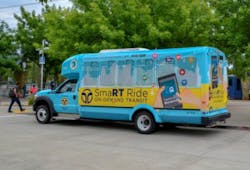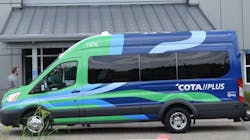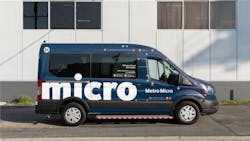By: Katherine Kortum, PhD, P.E.
Microtransit is a form of transportation known as demand-response, in which customer demand determines the routes that are provided. Those routes can change, even as frequently as daily, to serve customer needs.
In the era of COVID-19, as a result of reduced transit ridership as well as public concern about proximity to others, many transit agencies have been able to launch or expand microtransit options that either complement or substitute for traditional fixed-route transit services. Transit ridership has declined significantly since the beginning of the pandemic in the U.S. in March 2020; however, in many cities, at least half of previous riders (especially bus riders) continue to use transit. This only underscores the importance of providing transit service to a community and the need for agencies to be creative in their service offerings to address continued, if reduced, ridership at a time of lower revenues from fares, state contributions, and other sources.
One of the country’s largest microtransit services is provided by the Sacramento Regional Transit District (SacRT). SmaRT Ride, provided through a partnership with the mobility company Via, has operated since February 2018, providing more than 230,000 total rides at $2.50 each. Even as transit systems nationwide saw large ridership declines in 2020, SmaRT Ride only lost 15% of its riders. It operates 45 shuttles in nine zones, and began with a $12 million grant from the Sacramento Transportation Authority.
The Denton County Transportation Authority (DCTA) in Texas launched its own on-demand microtransit service in January 2019, providing connections in and around the Lakeway Business Park area. Using software from Spare Labs, the transit agency replaced portions of a fixed-route service with real-time service. In late March 2020, in response to the COVID-19 pandemic, DCTA expanded its on-demand transit service, again replacing fixed-route service with low ridership. The agency expanded its Lakeway Business Park service and began new service that served Old Town, MedPark, and Downtown Denton Transit Center train stations. Because of the agency’s existing partnership with Spare Labs, the new service was up and running within seven days.
In 2016, the City of Columbus, Ohio, won the U.S. Department of Transportation’s Smart City Challenge, resulting in a $50 million award for technology-oriented urban improvements. As part of this grant, the Central Ohio Transit Authority (COTA), the regional public transit provider for greater Columbus and Central Ohio, partnered with Via to launch COTA Plus in the Grove City region in July 2019. Using a mobile app powered by Via, customers could request on-demand rides, provided by COTA drivers, that arrived within fifteen minutes. In August 2020, in the midst of the COVID-19 pandemic, COTA expanded the service to Westerville, Northeast Columbus, and the South Side. This service supplemented the fixed routes which were suspended earlier in the pandemic due to low ridership. The initial service lived up to its promises, with an average thirteen minutes of waiting for customers, providing significantly better service than the fixed routes’ limited headways.
In April 2020, the SMART Bus system, which runs commuter bus routes in the Detroit area, replaced its fixed-route service with advanced reservation shuttles. Commuter volumes had dramatically decreased, and the system shifted to a process that required a customer to call or email with their location for pickup and dropoff and their preferred timing. SMART then provided either traditional-sized buses or small connector buses, depending on the demand and the need for spacing within the vehicle.
In Grand Rapids, Michigan, the transit system The Rapid launched a pre-scheduled and on-demand pilot program in partnership with Kaizen Health, Disability Advocates of Kent County, and the City of Grand Rapids. Starting in July 2020, the program used both an app and website to give passengers rides through The Rapid’s ADA paratransit service, Lyft, Uber, GoLux (chauffeur-provided service available in western Michigan), and other providers. This pilot project was funded in part from Kaizen Health’s winning submission to the Ford Motor Company’s City:One Challenge of 2018, which was designed to help identify new transportation solutions.
The Jacksonville Transportation Authority (JTA) in Florida partnered with Go Tuk’n Inc., beginning in July 2020, to provide on-demand rides in open-air electric shuttles. Unlike some agencies during the COVID-19 pandemic, which replaced existing fixed-route service with on-demand service, JTA’s service was in addition to the existing routes. While the service had been in the works pre-pandemic, the open-air shuttles—which are reminiscent of golf carts—were particularly well-considered during COVID-19 and given Jacksonville’s generally favorable climate. The service provides rides in downtown Jacksonville and the Riverside and Avondale neighborhoods.
Tucson, Arizona launched Sun on Demand in November 2020, allowing for on-demand shared rides between two designated service zones. Riders are able to make the reservations up to seven days in advance, but also on the day service is needed. Service is provided on a first-come, first-serve basis. Fares are currently free, as Tucson’s Sun Tran service has suspended all transit fares during the COVID-19 pandemic.
The sprawling city of Houston, Texas also offers on-demand transit service through its Community Connector program. Using an app (available since October 2020) or calling a service center (available since 2018), customers can request curb-to-curb transportation options that connect them with the larger transportation network at designated transfer points. Rides can be booked from fifteen minutes to seven days in advance. Community Connectors are currently offered in three regions of the city (Missouri City, Acres Homes, and Trinity Gardens) during specified hours, and rides cost $1.25—the same as regular bus fare.
In Los Angeles in December 2020, the L.A. County Metropolitan Transportation Authority recently began a new microtransit project termed “Metro Micro.” It is a three-year pilot project that will allow on-demand shared ride service within designated service zones and hours in Los Angeles County. Rides will cost $1 for the first six months, with potential fare adjustments after the initial six months. Payment is possible with a rider’s existing TAP (electronic fare) card, a debit card, a credit card, or a prepaid credit card, and each vehicle holds up to 10 passengers. The service began in December 2020 with two zones (Watts/Willowbrook and LAX/Inglewood). In January 2021, it expanded into three more zones: Compton/Artesia, El Monte, and North Hollywood.
Microtransit is still a small part of overall transit service within the United States, but it has shown promise, especially during the COVID-19 pandemic. Providing people, many of whom did not have the luxury of staying home and shifting their life to a virtual one, with options to work, shop, and learn exemplifies the type of essential service that transit provides at all times, and not only during the challenges presented by the pandemic. Transit agencies will continue to experiment with new forms of service provision, including microtransit, as they move people throughout the country every day.
About The Author: Kortum is senior program officer for the Transportation Research Board.






